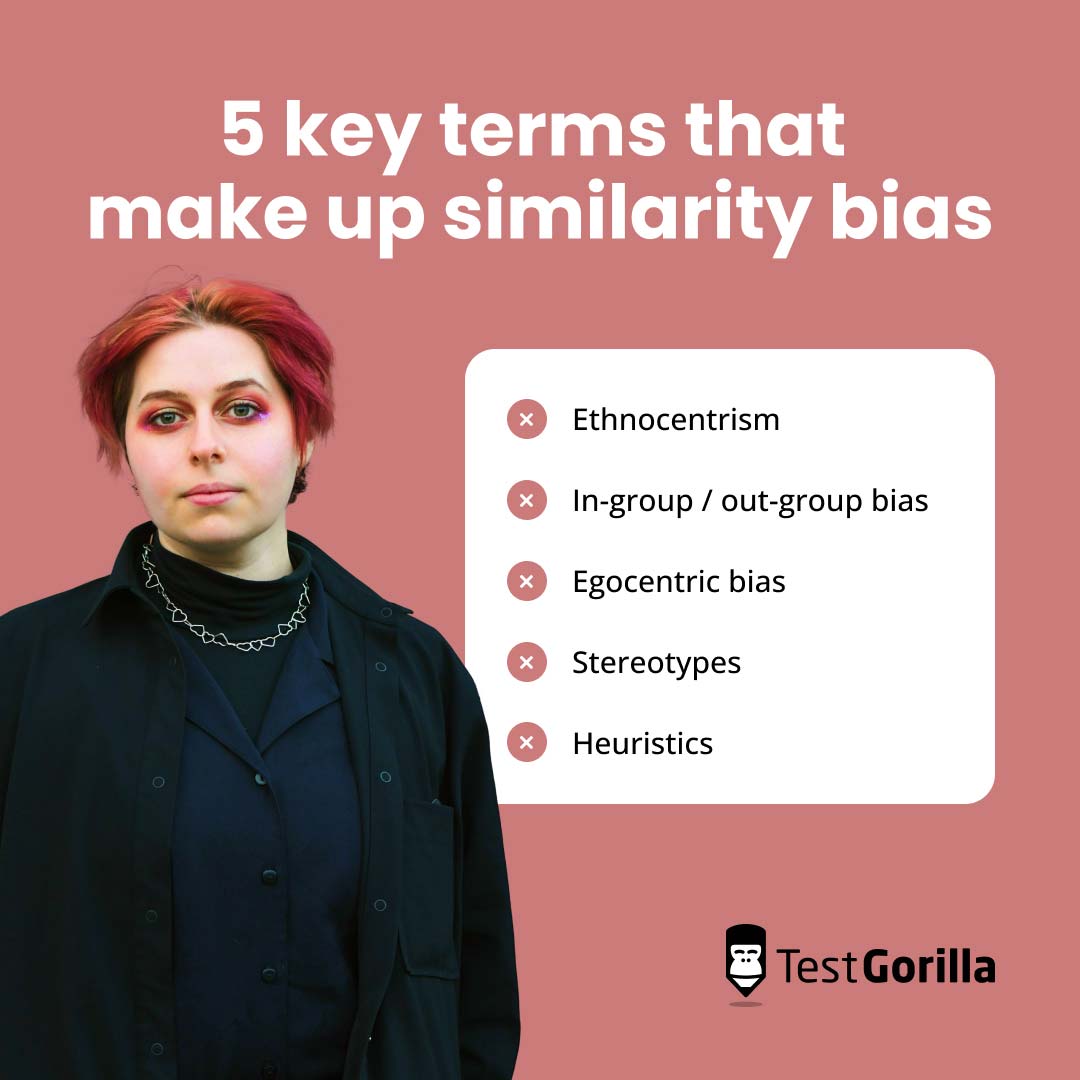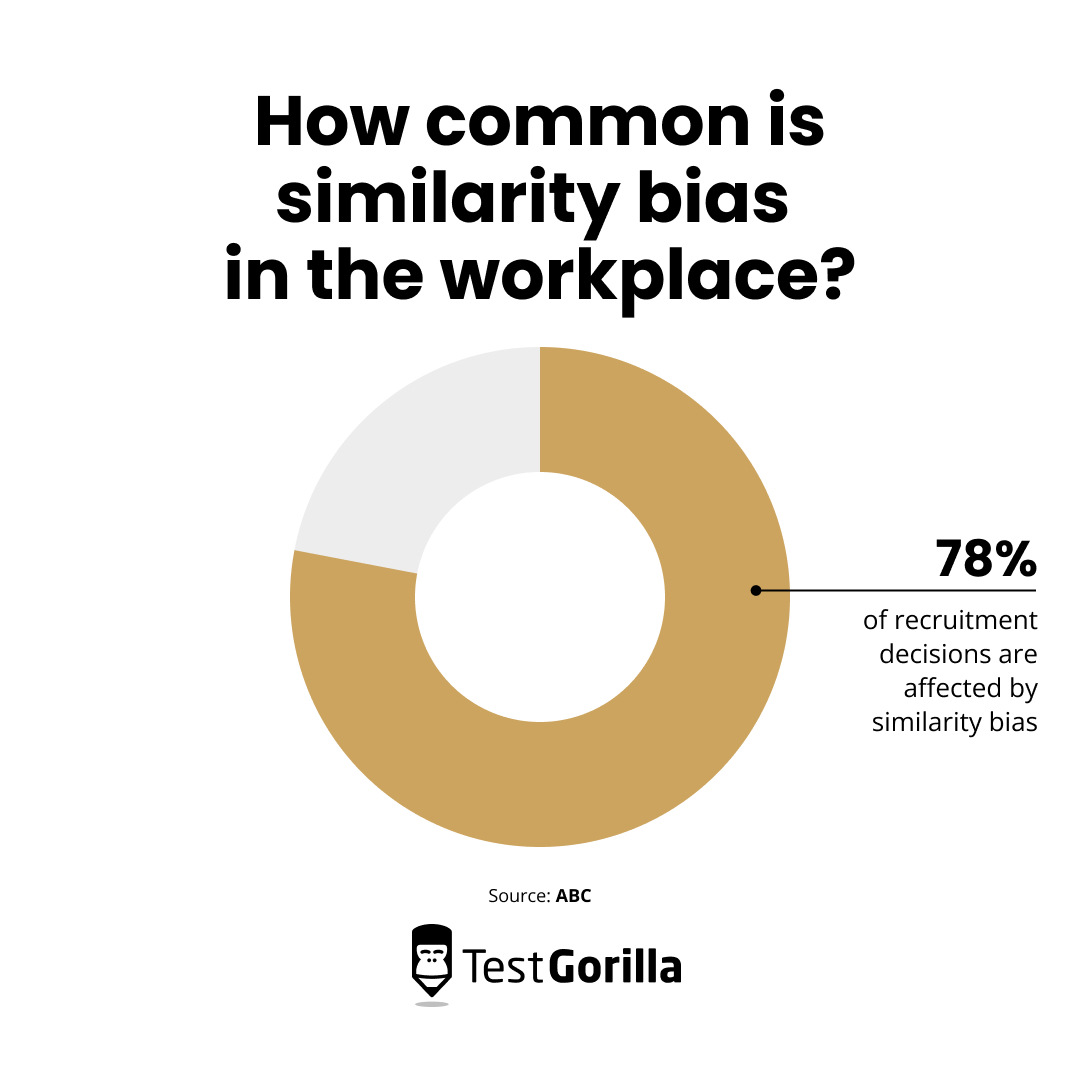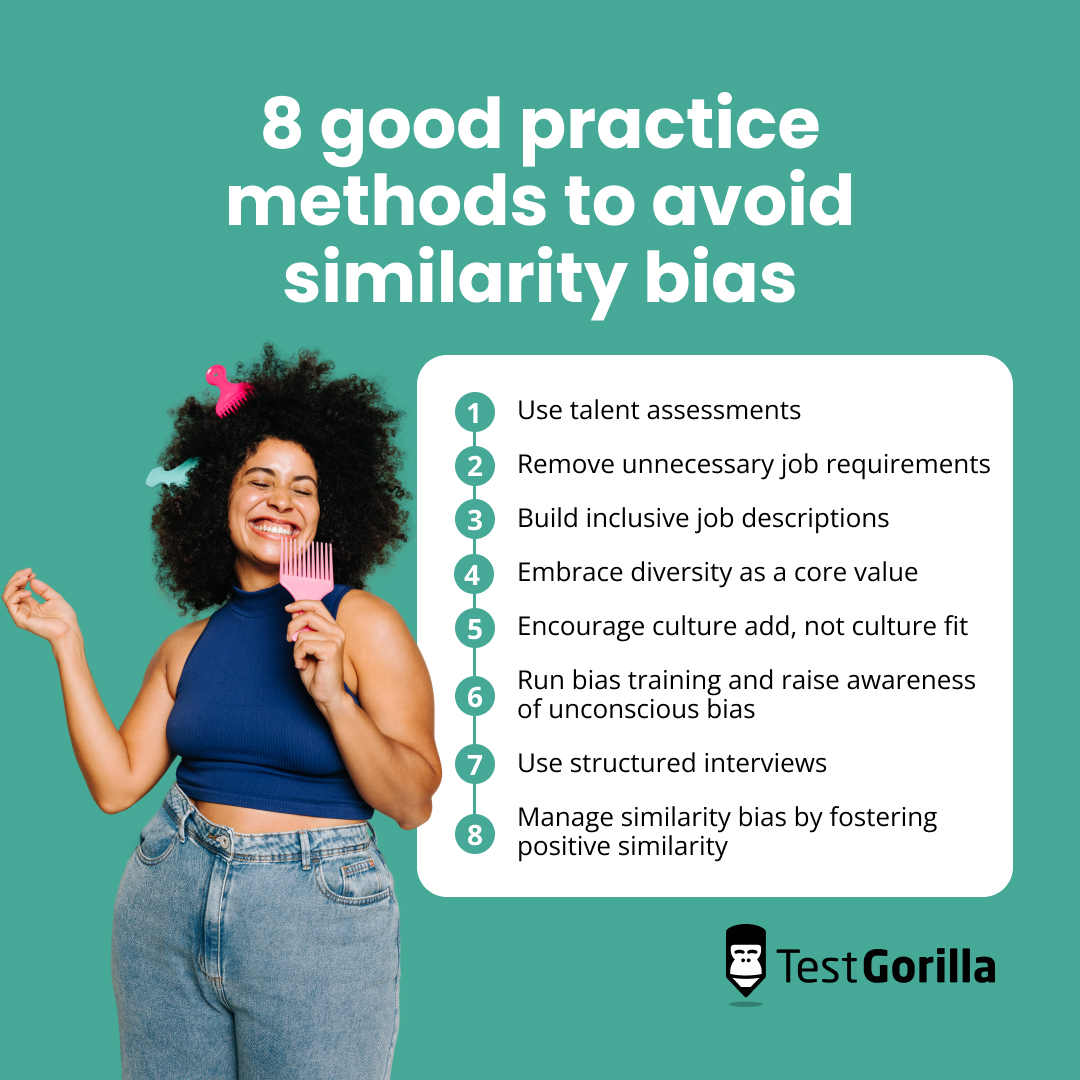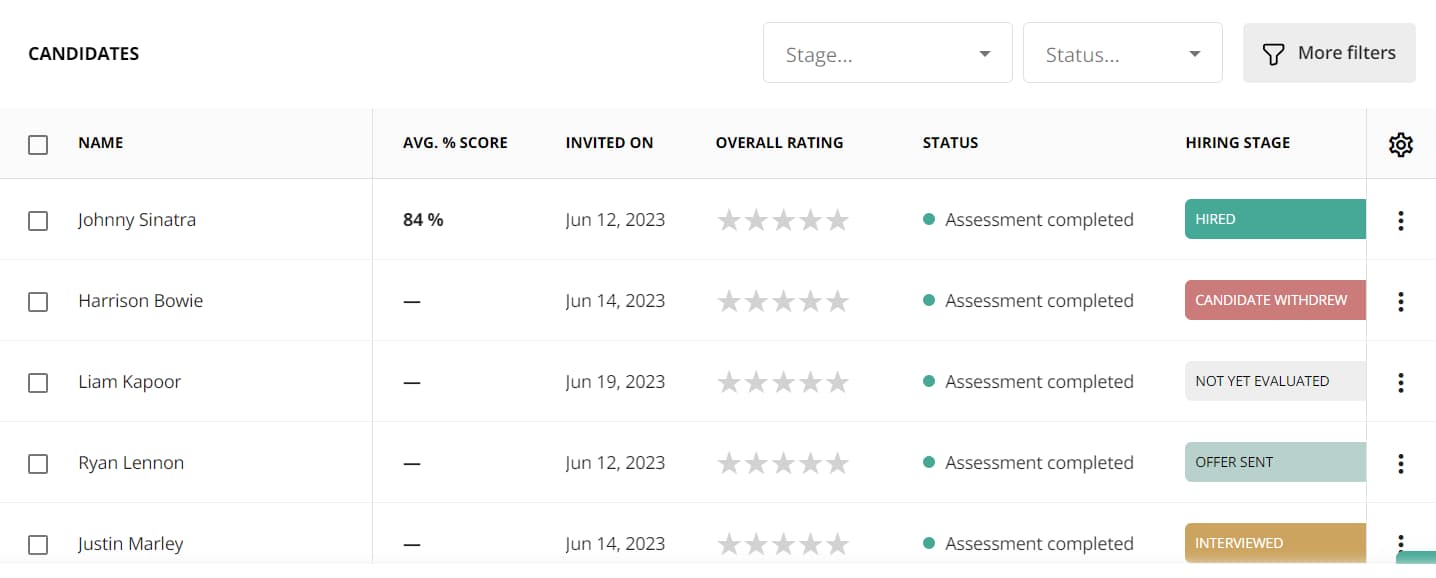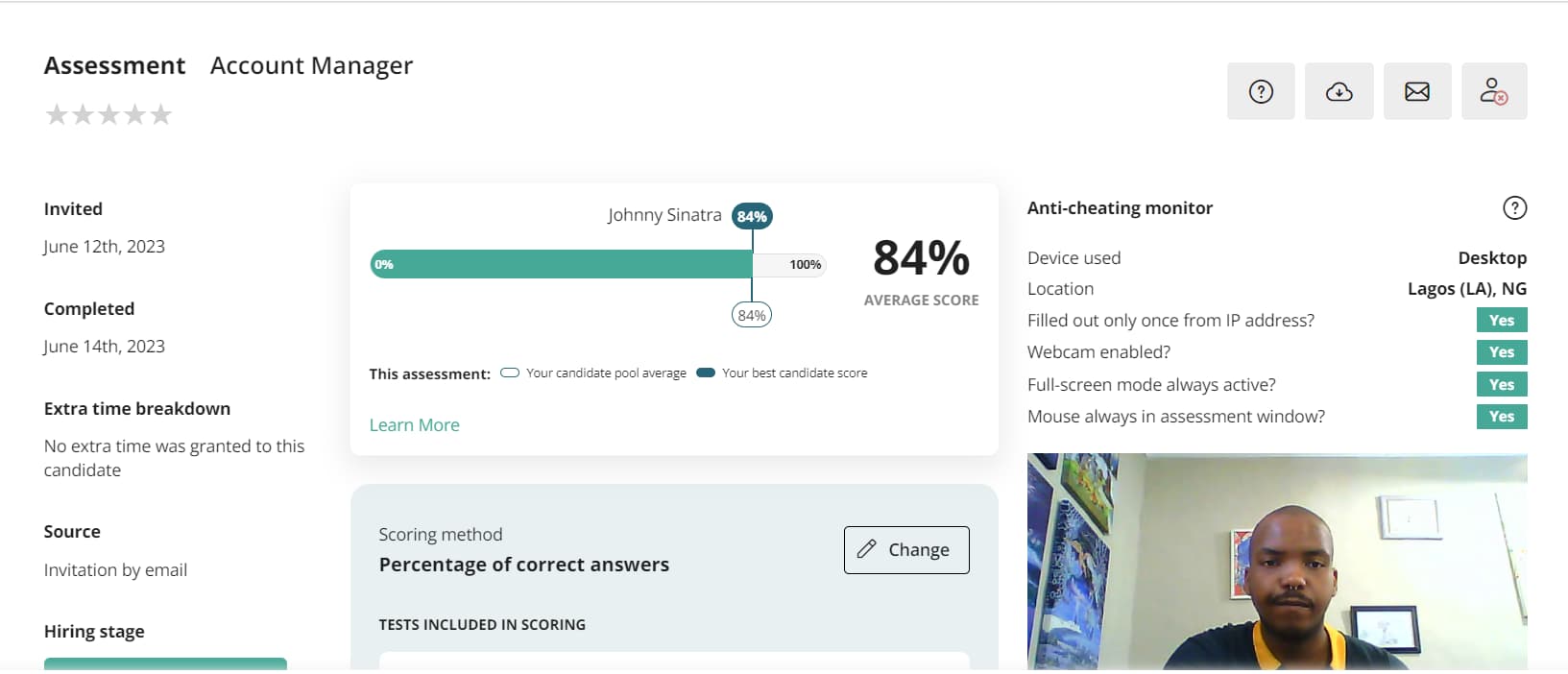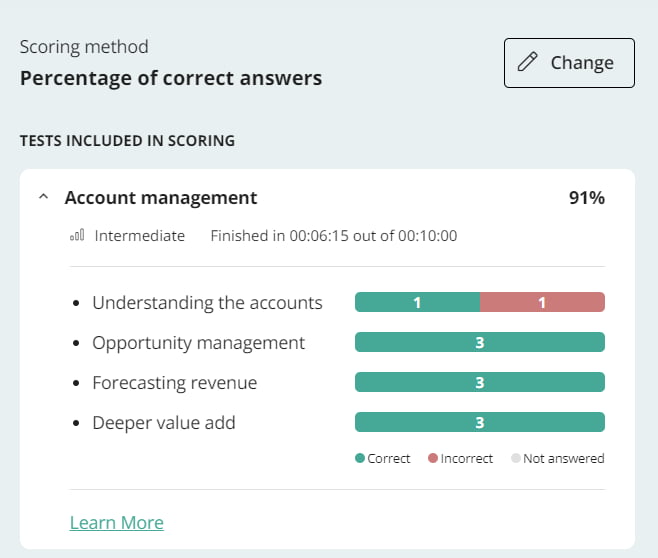Bias is an instinct that helps humans make decisions by automatically choosing what we believe to be the best option.
It has its uses in the wild, but using bias to hire in a modern business environment can lead to unfair hiring.
Similarity bias is a type of bias that makes us prefer things similar to ourselves. For example, a hiring manager could shortlist two candidates because they went to the same college.
People don’t intend bias to be harmful, but it can damage organizations by preventing them from hiring the best candidate for the role.
It can also damage your company's diversity, employer branding, and financial performance.
However, we aren’t helpless against it. Raising awareness of similarity bias helps your company make better hiring decisions, boost diversity, and build a healthy, inclusive culture.
This guide discusses similarity bias, which parts of work it crops up in, and best practices to reduce its influence.
What is similarity bias?
Similarity bias, also called affinity bias and like-me bias, is a form of unconscious bias where people prefer similar people, such as those sharing physical characteristics, educational backgrounds, or hobbies.
A similar phenomenon is assumed similarity bias, where a person overestimates how alike they are to another person.
William Sumner first discussed the similarity bias definition in 1906, using terms like “out-group” or “in-group” memberships to describe how we automatically sort people in our minds.
For example, a hiring manager who attended Yale may automatically sort candidates who also went there into their in-group.
Sumner also popularized the term “ethnocentrism,” which is the evaluation of other cultures based on preconceptions stemming from your own.[1]
Ethnocentrism is one of the key terms that make up similarity bias. Here are a few other related terms:
In-group / out-group bias: The tendency to favor or devalue a person based on whether they’re in or out of your group
Egocentric bias: The act of not considering situations from other perspectives
Stereotypes: A widely believed idea about a person or thing that is either oversimplified or false
Heuristics: Mental shortcuts that enable people to make quick decisions
All of these elements are part of similarity bias.
However, similarity bias isn’t the only bias at play. Let’s take a look at different types of bias.
The different types of unconscious bias
Many different varieties of bias happen at work. After all, cognitive biases are how individuals naturally make quick decisions about organizational behavior.
Here are the most common types of bias:
Experience bias: Using our own experience as objective truth
Conformity bias: Taking cues from others to conform to a group instead of using your own opinions
Confirmation bias: The concept of unconsciously trying to confirm your first impressions of a person
Recency bias: Remembering your most recent experiences more than earlier ones
Gender bias: Perceiving or judging someone because of their gender
Let’s touch on that last point.
It’s important to note that gender bias isn’t necessarily the same as similarity bias.
Stereotypes abound about which jobs are right for certain genders, illustrated by the fact that there are fewer men in healthcare and education roles, for example.
Another example is the study that found that male and female hiring managers were twice as likely to hire men for STEM positions. The research concluded that most hiring managers unconsciously and incorrectly believed that men were more talented in science and math.[2]
Gender bias is one of the main obstacles standing in the way of STEM equality.
Ernesto Reuben, the lead author of the study, had this to say:
“[H]iring managers possess an extraordinary level of gender bias when making decisions and filling positions, often choosing the less qualified male over a superiorly qualified female.”
For more information on different types of unconscious bias, read our article on interviewer bias.
What factors into similarity bias?
Many elements factor into similarity bias – many more than you may think. After all, anything you can have in common with another person can factor into similarity bias.
Here are a few similarity bias examples:
Physical appearance
Hobbies
Educational background
Work history
Beliefs
Lifestyle
Ethnicity and culture
Sexual orientation
Gender
Likes and dislikes
There are many opportunities to be affected by bias, making it unfortunately easy to fall into.
Remember that biases aren’t our fault and don’t reflect who we are, but they can still be harmful.
For example, few people would try to hire or promote someone only because they share traits with them. Yet, it happens all the time.
Nevertheless, we can learn how to overcome similarity bias and what we all do without thinking.
How does similarity bias in the workplace affect your company?
Similarity effect bias can affect every part of a company, from hiring to performance reviews to daily work.
When similarity bias is left unchecked, it can lead to a homogenous culture, groupthink, loss of innovation, and unintentional discrimination.
These negative effects of similarity bias affect your corporate reputation and stifle your company’s creativity and performance.
Of course, similarity bias has some positive effects, such as how people feel more comfortable or aligned with similar people.
But there are ways we can achieve these benefits without falling prey to bias, such as helping people with similar interests or lifestyles come together at work through employee resource groups.
Feel free to jump ahead to our tips on managing similarity bias if you’re eager to start.
Hiring and recruiting
Many decision makers use similarity bias in hiring to help shortlist candidates, but it can be seriously damaging.
An example of similarity bias is a hiring manager choosing certain applicants because their work history is similar to the manager’s own experience.
The manager could do this because they believe that work history benefits the position. They’re successful at the company and believe it’s a key indicator of good performance.
Alternatively, they could feel a connection to the candidates.
Similarity bias is common when hiring.
One study found it was a significant factor in 78% of recruitment decisions.
These decision-making processes can quickly lead to mis-hires and unfair hiring. Either of these outcomes is possible in our example from earlier.
Just because those candidates had the same work history doesn’t guarantee good performance. Further, the hiring manager may neglect an excellent applicant because they don’t possess the right work history.
Performance reviews
Similarity bias in the workplace reaches many corners of an organization and can harm performance reviews.
It leads to us viewing similar people as better performers, making out-group performers work harder to impress us.
For example, if a manager and his in-group are all heterosexual males, he may judge their performance to be better than that of the one lesbian on his team.
Further, preferential treatment could eventually cause favored employees to perform better.
Similarity bias can make managers devote more time to employees who are like them, giving them better coaching and more development opportunities, which leads to our next point.
Opportunities and promotions
Similarity bias can cause senior workers to coach certain employees more attentively than others, enhancing their skills purely because they’re similar to their managers.
This bias also affects learning and development in another way. It could be easier for managers to spot potential in people similar to them.
Managers may instinctively notice good performance and transferable skills in similar people and recommend them for internal advancement.
Our example from above works well here. A manager may believe they have evidence that an employee has what it takes to upskill because they have the same background.
Daily work and recognition
It’s easier to recognize good performance when someone is similar to you. After all, different work styles can all get the job done, but are still a common cause of workplace conflict.
Similarity bias can also cause favoritism in the workplace. Recognizing good performance in similar people can cause conscious or unconscious favoritism after some time.
Similarity bias also impacts the way people work together.
It affects how people interact because they can be uncomfortable around people who are different but naturally feel comfortable around similar people.
Similarity bias commonly affects boardrooms. A senior manager could narrow their pool of potential boardroom candidates, which can lead to groupthink and reduce the innovation diverse teams can bring.
The best insights on HR and recruitment, delivered to your inbox.
Biweekly updates. No spam. Unsubscribe any time.
How to avoid similarity bias: 8 methods to implement in your organization
Unconscious bias can affect your entire organization, from choosing the wrong candidate during hiring to passing up an excellent employee for a promotion.
Similarity bias damages your overall performance and reputation, but there are ways to mitigate it.
Learning to overcome similarity bias is crucial to your company’s success, so let’s look at our top eight methods.
Strategies to manage similarity bias: A summary
Strategies | What it accomplishes |
1. Use talent assessments to reduce your reliance on bias | Objectively determines candidate capabilities without considering their gender, age, or race |
2. Remove unnecessary job requirements from open roles | Includes all qualified candidates and opens your talent pool |
3. Build inclusive job descriptions | Attracts the right professionals by listing the exact skills needed for the role and using inclusive language |
4. Embrace diversity as a core value in your company culture | Implements diverse practices throughout your organization to build a foundation of inclusion |
5. Encourage culture add, not culture fit | Hires candidates for their core values yet still welcomes diversity |
6. Run bias training and raise awareness of unconscious bias | Raises awareness of similarity bias, but isn’t a full fix on its own |
7. Use structured interviews to reduce the chance of similarity bias | Reduces small talk and going off-topic, which can quickly lead to similarity bias |
8. Manage similarity bias by fostering positive similarity | Nurtures healthy togetherness without seeming forced |
1. Use talent assessments to reduce your reliance on bias
It’s easy to rely on bias during recruitment. Even when you know your potential biases, they can still influence you.
The best way to reduce similarity bias and all types of unconscious bias is to objectively evaluate each candidate’s skills. You can do this with talent assessment tests.
Talent assessments help reduce similarity bias by gauging applicants’ skills and competencies without considering background, education, gender, race, or age.
They’re similar to blind hiring practices, like removing names and photos from resumes, but go the extra mile by removing more chances for bias, such as work history.
Skills tests also give you confidence when filling a role because you know candidates have the skills to complete their responsibilities successfully. Judging them by a resume doesn’t securely tell you if they’re qualified.
After candidates complete their assessments, you sort the best of them out based on their test scores, taking your own opinions and biases out of the shortlisting process.
Here’s how to do it with TestGorilla’s assessments:
This candidate database is where you sort applicants by test score. You can see their average score from the list and click on each name for more details.
A closer look shows how this candidate scored by comparison with others, which anti-cheating measures were in effect, and deep insights into each test they took.
You can see that Johnny Sinatra scored 91% on the Account Management test, achieving a perfect score in three out of four subjects.
This system is the ideal way to reduce similarity bias in hiring, giving every professional an equal chance and providing your company with the best person for the role.
2. Remove unnecessary job requirements from open roles
Many typical job requirements unconsciously encourage similarity bias in the hiring process. These requirements also affect learning opportunities and promotions.
The worst offender in job descriptions is the four-year degree, which, owing to degree inflation, is common even in junior and entry-level positions.
Here are a few job requirement similarity bias examples:
Requiring college degrees
Requiring years of work experience
Requiring certain skills because you believe they are necessary
Let’s quickly expand on this last point.
A hiring manager may believe certain skills are necessary for a role because they have them. They could have also worked in a similar position that required those skills, so they assumed they were necessary.
You can avoid similarity bias in job descriptions by assessing the role critically and objectively.
Ask people in similar roles for their input to get a broader perspective, and if possible, use talent assessments to determine which hard and soft skills are necessary.
These methods enable you to collect relevant data to inform your job descriptions rather than asking for years of experience or college education. It reduces similarity bias in the workplace and helps you hire the best candidate.
3. Build inclusive job descriptions
We previously discussed finding the necessary skills for a role, so let’s dive deeper.
You can leverage talent assessments to discover which skills belong to each job role, including technical skills like Python coding and cognitive abilities like attention to detail.
Simply test employees in this role to determine which skills and competencies they use daily. Are your top performers great negotiators? If they aren’t, it indicates that their positions don’t require negotiation skills.
You can build an effective, inclusive job description now that you have accurate information on what it takes to succeed.
We recommend using inclusive language to build your job description, like using gender-neutral terms and avoiding coded language.
For more information on this, check out our piece on inclusive hiring.
4. Embrace diversity as a core value in your company culture
It’s much easier to reduce similarity and other forms of bias when you embrace diversity rather than just adopting a few processes.
Adopt inclusion as a core value in your company culture and encourage it wherever possible.
Here are a few ways to implement diversity in your organization:
Adopt inclusive hiring practices
Have leadership openly discuss inclusivity
Don’t just accept differences, embrace them
Promote a culture of learning
Establish psychological safety
Offer special accommodations to those who need them
Building an inclusive culture promotes the idea that capability can occur in anyone, not just in people like us, which gradually combats similarity bias and helps us form new opinions.
It also creates a better culture for diverse employees to thrive in. Every employee wants to be a part of an organization where they’re accepted and heard.
5. Encourage culture add, not culture fit
Nearly every recruiter would tell you cultural alignment is important in hiring a new employee.
Traditionally, we relied on culture fit to gauge this. This method is problematic and relies too heavily on making every employee fit a specific mold.
The best way to gauge cultural alignment is by assessing if a candidate is a culture add. Culture add ensures candidates hold important values but leaves room for unique perspectives and diversity.
It is an excellent method for decreasing similarity bias and encouraging inclusive hiring.
Culture add helps define core values, such as trust and efficiency, which are solid common ground to establish in a workforce. Research has found that finding common ground is a great way to alleviate similarity bias.
You can assess culture add by evaluating candidates with our Culture Add test, which helps discover core values and behaviors necessary for your team and promote workplace diversity.
6. Run bias training and raise awareness of unconscious bias
Knowing how to avoid similarity bias starts with awareness, and a great way to raise awareness is through bias training.
Bias training is any program designed to address and help people confront unconscious biases. It usually aims to adjust and improve innate biases.
These programs can be in-person, online, and instructor-led. Your company can also provide an online document for each employee to read.
Bias training usually follows a three-step process:
Participants test their biases to understand their baseline bias levels
Participants complete the bias training program
Participants test their bias levels again to check for improvement
These training programs are a useful tool to raise awareness, which is helpful – if you aren’t aware of your biases, you aren’t capable of shifting your behaviors.
However, bias training isn’t perfect.
We recommend always pairing bias training with other efforts, such as skills-based hiring practices and efforts to create a more inclusive culture. Bias training is not enough on its own.
For more information, read our blog on implicit bias training.
7. Use structured interviews to reduce the chance of similarity bias
Standard job interviews or unstructured interviews leave many opportunities for similarity bias in hiring.
The unstructured interview process facilitates interviewers getting chummy with candidates and looking for similarities to make decisions.
However, structured interviews drastically reduce the chance of bias during an interview.
Here’s a quick comparison between the two:
Structured interviews | Unstructured interviews |
- Use a script - Determine success criteria in advance - Ask relevant situational and behavioral questions - Always revert to the script | - Go into the interview with a vague idea of the necessary questions - No predetermined success criteria - Ask any questions, including abstract ones - Frequently go off-topic to discuss common interests |
Structured interviews are a great guard against similarity effect bias.
Using a script and predetermined criteria reduces the chance of small talk about hobbies, backgrounds, and other factors that lead interviewers to prefer a candidate owing to similarity bias.
For example, suppose an interviewer talks about their tennis hobby with the candidate. Whichever candidate plays tennis could be shortlisted, even if other candidates could perform the role better.
8. Manage similarity bias by fostering positive similarity
There are positive aspects of similarity bias, such as feeling more comfortable and aligned with people who are similar to you, which aren’t inherently bad.
You can celebrate the similarities in your workforce and benefit from the alignment you share with others.
Here are some steps you can take:
Encourage employees with similar interests to talk and interact
Provide employee resource groups so individuals can share their experiences and offer support
Ensure that every opportunity to celebrate similarities is optional and not forced
There’s nothing wrong with being similar. Having the same interests, backgrounds, education, or hobbies can bring people together and build great working relationships.
The main thing to be aware of is how your similarity bias affects decision-making and business outcomes and the damage it can cause.
Reduce and manage similarity bias with talent assessments
Recognizing and avoiding similarity bias is essential to building a healthy workplace.
Overcoming similarity bias helps you make better decisions, reduces unintentional discrimination, and leads to better business outcomes.
One of the most powerful, effective ways to do this is by evaluating applicants with talent assessments. These tests enable you to discover the most qualified candidates without bias getting in the way.
For more information on how talent assessments help combat bias, check out our piece on bias in hiring.
If you’re interested in browsing our talent assessments, take a look at our test library.
Sources
Bizumic, Boris. (January 31, 2014). "Who Coined the Concept of Ethnocentrism? A Brief Report". Journal of Social and Political Psychology. Retrieved November 21, 2023. https://jspp.psychopen.eu/index.php/jspp/article/view/4799/4799.html
Reuben, Ernesto; Sapienza, Paola; Zingales, Luigi. (March 10, 2014). “How stereotypes impair women’s careers in science”. PNAS. Retrieved November 24, 2023. https://www.pnas.org/doi/abs/10.1073/pnas.1314788111
Related posts
You've scrolled this far
Why not try TestGorilla for free, and see what happens when you put skills first.


